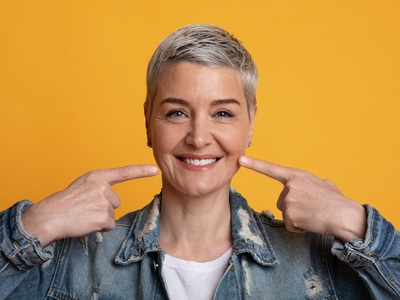
The Jaw
The jaw and the bones, muscles, and joints that make up the jaw are important to the structure of the face and are the foundation of your bite. The fit of the upper and lower jaw bones is a big part of your orthodontic health. The upper jaw, or maxilla, is the stationary bone of the jaw. It connects to the lower jaw, or mandible at the temple to form the joint of the jaw. The mandible is the moveable half of the jaw joint, more formally known as the temporomandibular joint.
The temporomandibular joint (TMJ) is an articulate joint, meaning it moves. Both the upper and lower jaws are in halves that meet in the center of the face when properly aligned. This centering of the jaw halves is an essential part of the health of your bite. Misalignment of the jaw can lead to muscle stress when swallowing, chewing, and sleeping.
Pain around the jaw and face could also be a result of a jaw disorder, or TMDs (Temporomandibular joint disorders). The National Institutes of Health estimate that 5 to 10% of adults have a jaw disorder. This is a condition that affects the temporomandibular joint, which is the hinge that connects the lower jaw to the skull. TMJ syndrome can cause a wide range of symptoms, including pain in the jaw, face, neck, and shoulders; clicking or popping sounds when moving the jaw; and difficulty opening or closing the mouth.
The Tooth
The teeth are hard, bony structures connected to both the upper and lower jaw bones. There are 32 permanent teeth and 20 baby teeth. The teeth are used for chewing food and they also help to keep the mouth clean. Each tooth is composed of four layers of tissues.
Three of these layers are hard tissue, which means they are made of bone-like organic material. These three layers are called the enamel, dentin, and cementum, and make up the hard parts of the tooth, while the pulp, a soft tissue, houses the nerves present on the inside of the tooth. The cementum covers the root of the tooth below the gum line.
Unusual movement or alignment of the jaw can cause tooth stress, which in turn can hurt enamel and cause wear on teeth prematurely. The part of the jawbone that the teeth connect to is the alveolar bone, part of the tooth joint system.
Orthodontic Movement
The upper teeth and lower teeth having a healthy and centered bite is the primary goal of orthodontics. Misalignment or malocclusion is where the teeth do not line up correctly when the mouth is closed. Misaligned teeth can be caused by genetics, injury, or tooth grinding (bruxism). They can lead to problems with eating and speaking, as well as an increased risk of tooth decay and gum disease. To treat malocclusion, orthodontists use a variety of appliances, braces, or even tooth extraction.
Moving teeth is a slow process because it involves the destruction and formation of bone. For optimal timing and health, teeth should move about a millimeter a month. It may seem like a short distance, but this movement greatly improves health and the structure of the facial bones.
After treatment, because the new bone needs to mature to prevent relapse, a retainer is necessary.
As always please feel free to call and schedule an appointment if you have questions or concerns. We are always available to answer any of your questions.